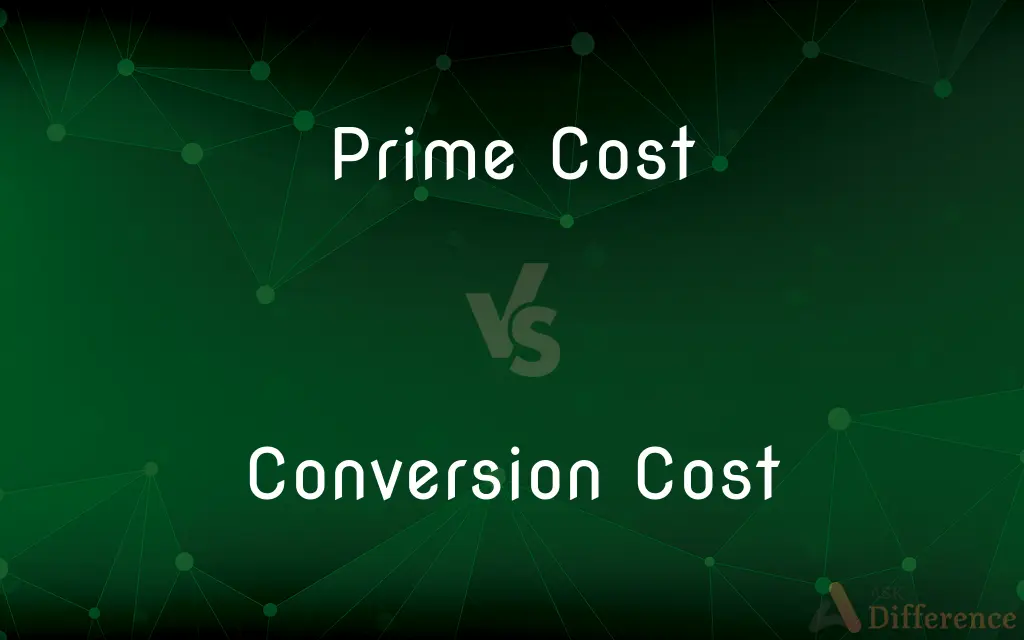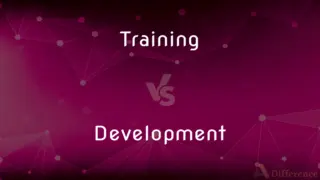Prime Cost vs. Conversion Cost — What's the Difference?
By Tayyaba Rehman — Published on October 2, 2023
Prime Cost is the total of direct labor and direct materials costs; Conversion Cost is the total of direct labor and manufacturing overhead costs.

Difference Between Prime Cost and Conversion Cost
Table of Contents
ADVERTISEMENT
Key Differences
Prime Cost and Conversion Cost are integral concepts in cost accounting, essential for determining the total production cost of goods manufactured. Prime Cost refers to the combined cost of direct materials and direct labor used in the production process. It represents the initial expenses incurred to produce goods and is essential for pricing and profitability analysis. In contrast, Conversion Cost is the total cost of converting raw materials into finished goods, encompassing both direct labor and manufacturing overhead costs. It is crucial for understanding the efficiency of the production process and managing operational expenses.
While Prime Cost focuses primarily on the tangible inputs in the production process, Conversion Cost considers the comprehensive costs associated with transforming raw materials into final products. Prime Cost helps in analyzing the direct costs and is crucial for establishing product prices and assessing the cost-effectiveness of production methods. Conversion Cost, however, reflects the broader aspects of the manufacturing process, highlighting the efficiency and productivity of the production line and aiding in optimizing operational workflows and resource allocation.
In costing and budgeting, accurately calculating Prime Cost is pivotal for effective pricing strategies and cost management, ensuring that the costs of direct inputs are appropriately covered in the product prices. It provides insights into the variable costs of production, aiding in break-even analysis and profitability assessments. Conversely, understanding Conversion Cost is essential for operational efficiency, allowing manufacturers to assess and optimize the use of labor and resources in the production process, thus controlling overhead costs and improving overall production efficacy.
Understanding the difference and relationship between Prime Cost and Conversion Cost is vital for comprehensive cost analysis. While Prime Cost provides a base, focusing on the direct costs, Conversion Cost builds upon it, incorporating the additional costs related to the transformation of raw materials. Both are critical for determining the total production cost and are used conjointly in cost accounting to assess the financial performance and viability of manufacturing operations.
In conclusion, Prime Cost and Conversion Cost serve different but complementary roles in cost accounting, one providing insights into the direct costs of production and the other focusing on the comprehensive costs of transforming materials into finished goods. Accurate computation and analysis of both are imperative for informed decision-making, effective resource allocation, and strategic pricing in the manufacturing sector.
ADVERTISEMENT
Comparison Chart
Components
Direct materials and direct labor
Direct labor and manufacturing overhead
Focus
Initial expenses and direct costs of production
Costs associated with transforming raw materials
Importance
Essential for pricing and profitability analysis
Crucial for assessing production efficiency
Application
Costing, budgeting, and pricing strategies
Operational workflow optimization and cost control
Impact
Affects product prices and cost management
Influences operational efficiency and resource use
Compare with Definitions
Prime Cost
Prime Cost is crucial for effective pricing strategies and cost management in manufacturing.
Accurate calculation of the prime cost is pivotal for determining the product’s selling price.
Conversion Cost
Conversion Cost aids in optimizing operational workflows and resource allocation in manufacturing.
Monitoring the conversion cost regularly helped in optimizing resource allocation in the production units.
Prime Cost
Prime Cost provides insights into the variable costs of production.
Evaluating the prime cost helped in conducting a detailed break-even analysis for the new product line.
Conversion Cost
Conversion Cost includes the costs of direct labor and manufacturing overhead required to transform raw materials.
Optimizing the conversion cost is essential for enhancing the overall production efficacy.
Prime Cost
Prime Cost is integral for assessing the cost-effectiveness of production methods.
A reduction in prime cost indicated the efficiency of the new production method adopted by the company.
Conversion Cost
Conversion Cost provides insights into the comprehensive costs of manufacturing beyond direct inputs.
By assessing conversion cost, the manufacturer could identify inefficiencies in the production process.
Prime Cost
Prime Cost is the sum of direct materials and direct labor costs in production.
The company analyzed the prime cost to set a competitive price for the new product.
Conversion Cost
Conversion Cost reflects the efficiency and productivity of the production line.
The company aimed to reduce conversion cost to improve production efficiency.
Prime Cost
Prime Cost represents the initial expenditures incurred in the manufacturing process.
By reducing the prime cost, the manufacturer could improve the profit margins.
Conversion Cost
Conversion Cost is vital for managing operational expenses in the manufacturing process.
A detailed analysis of the conversion cost revealed areas for potential savings in operational expenses.
Common Curiosities
Can Prime Cost affect a product’s selling price?
Yes, accurate calculation of Prime Cost is pivotal for determining a product’s selling price and ensuring profitability.
How does Conversion Cost impact manufacturing?
Conversion Cost impacts the efficiency and resource use in manufacturing, aiding in operational workflow optimization and cost control.
Can Conversion Cost reveal inefficiencies in production?
Absolutely, assessing Conversion Cost can help identify inefficiencies and areas for improvement in the production process.
What does Conversion Cost represent?
Conversion Cost represents the total of direct labor and manufacturing overhead costs, reflecting the efficiency of the production process.
What is Prime Cost?
Prime Cost is the total of direct materials and direct labor costs in production, essential for pricing and profitability analysis.
Is Conversion Cost related to operational efficiency?
Yes, Conversion Cost is crucial for assessing and improving operational efficiency and productivity in the production process.
Is Prime Cost focused on direct costs of production?
Yes, Prime Cost focuses primarily on the direct materials and labor costs, representing the initial expenses in production.
Is reducing Prime Cost beneficial for manufacturers?
Absolutely, reducing Prime Cost can improve profit margins and enhance the cost-effectiveness of production methods.
How is Conversion Cost used in resource allocation?
Conversion Cost is used to optimize operational workflows and ensure efficient allocation of resources in the manufacturing process.
Does Prime Cost impact cost management?
Yes, Prime Cost is integral for effective cost management and budgeting in the manufacturing sector.
Is Prime Cost vital for break-even analysis?
Indeed, analyzing Prime Cost provides insights into the variable costs of production, aiding in detailed break-even analysis.
Why is Prime Cost important?
Prime Cost is crucial for effective pricing strategies, cost management, and provides insights into the direct costs of production.
Can Conversion Cost control operational expenses?
Yes, understanding and managing Conversion Cost is vital for controlling and reducing operational expenses in manufacturing.
Share Your Discovery

Previous Comparison
Training vs. Development
Next Comparison
Scarcity vs. AbundanceAuthor Spotlight
Written by
Tayyaba RehmanTayyaba Rehman is a distinguished writer, currently serving as a primary contributor to askdifference.com. As a researcher in semantics and etymology, Tayyaba's passion for the complexity of languages and their distinctions has found a perfect home on the platform. Tayyaba delves into the intricacies of language, distinguishing between commonly confused words and phrases, thereby providing clarity for readers worldwide.
















































